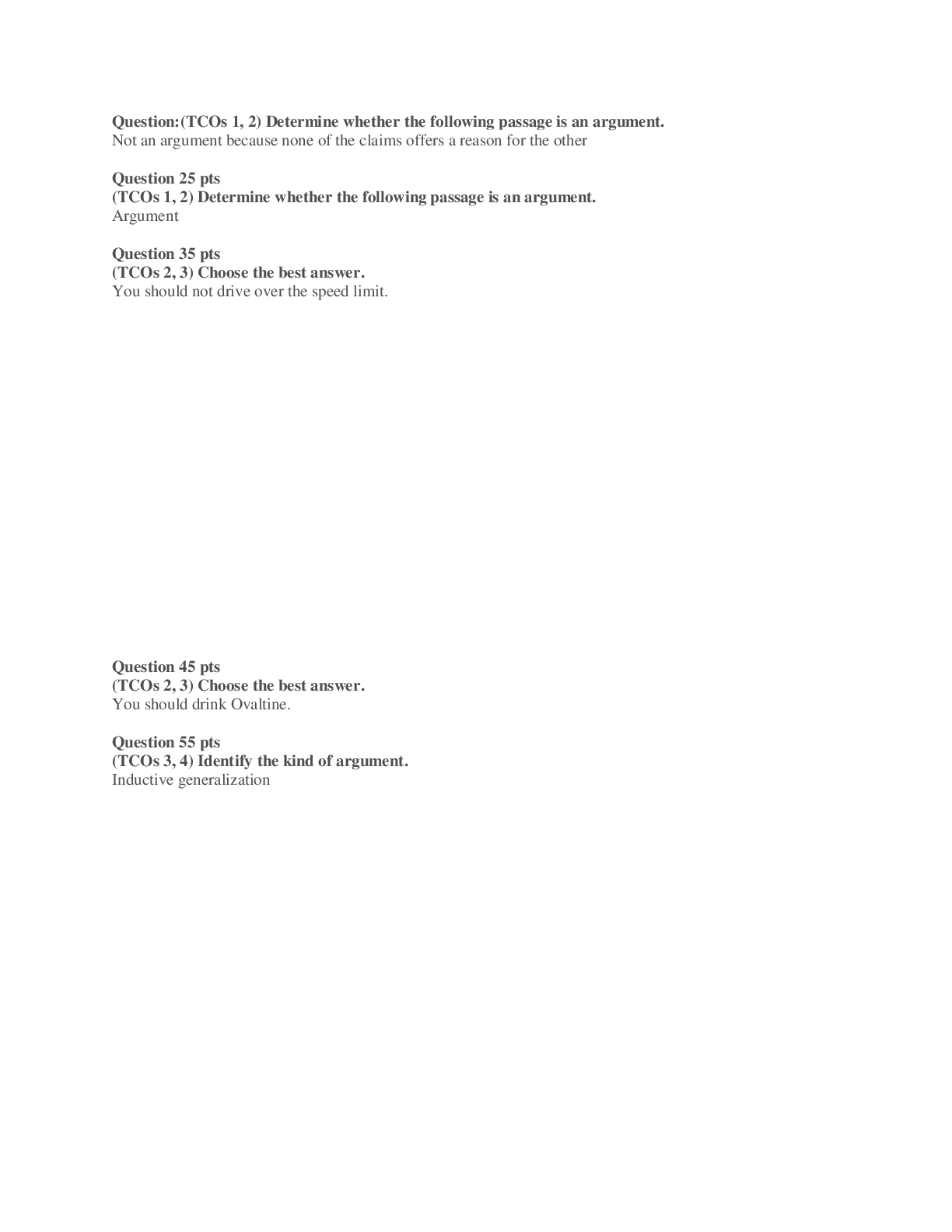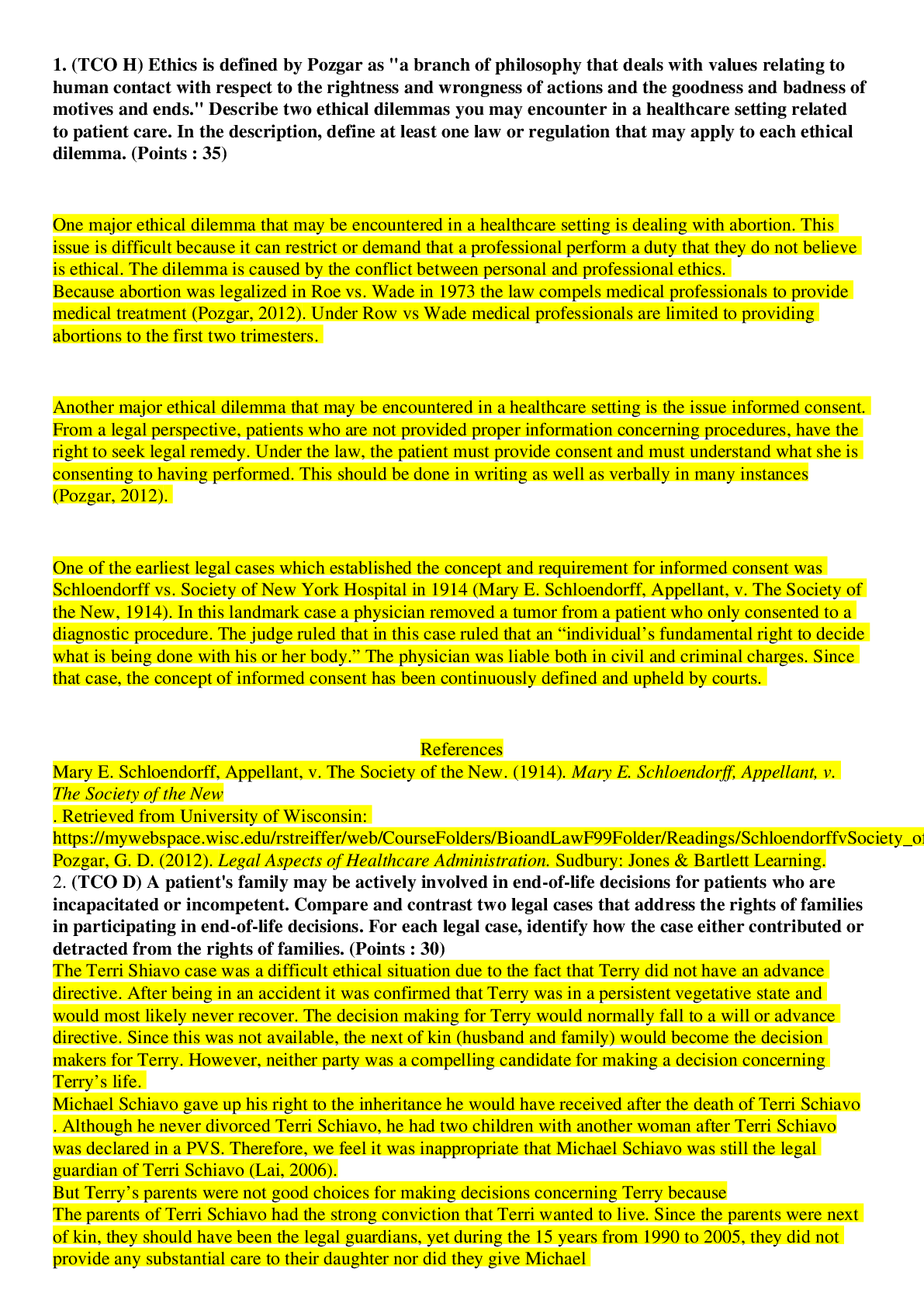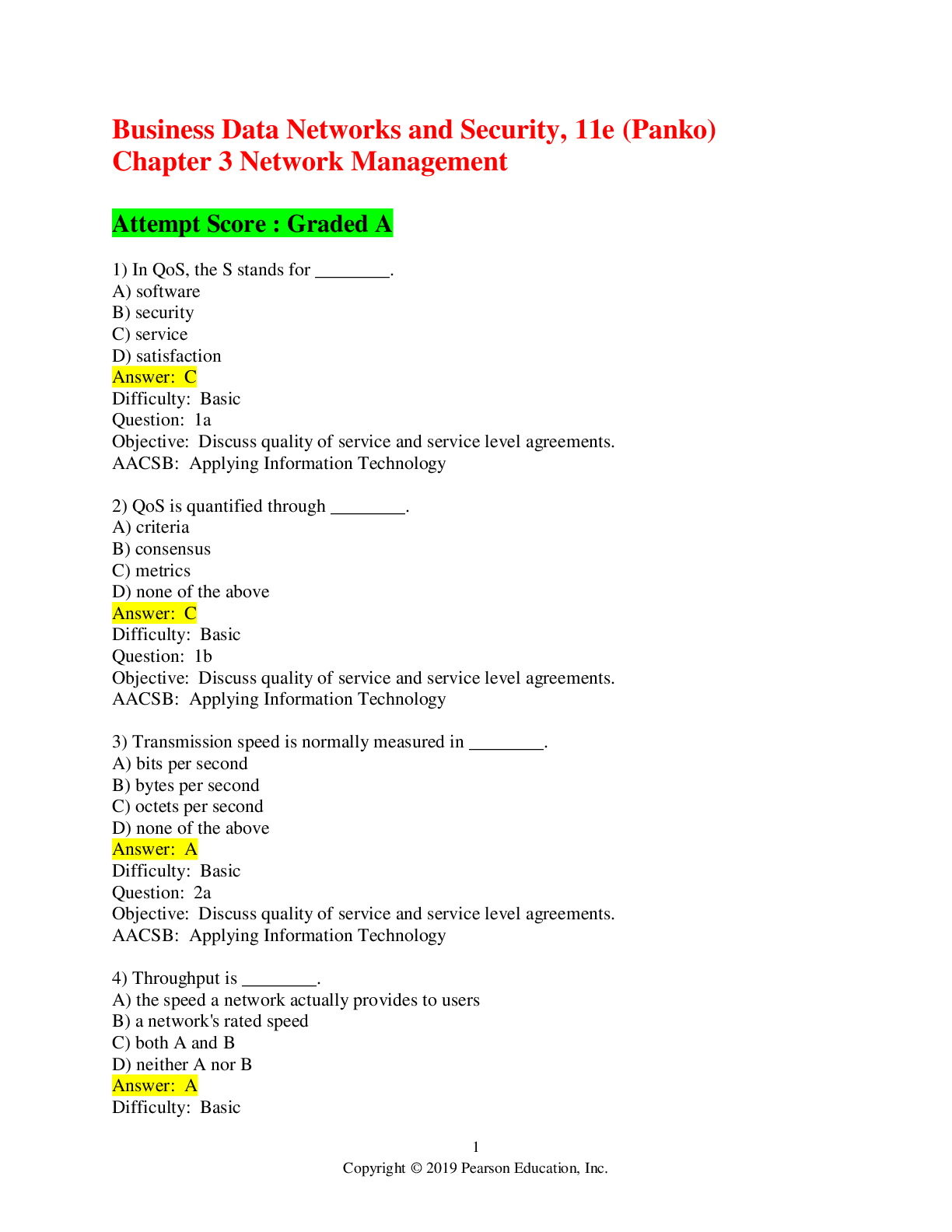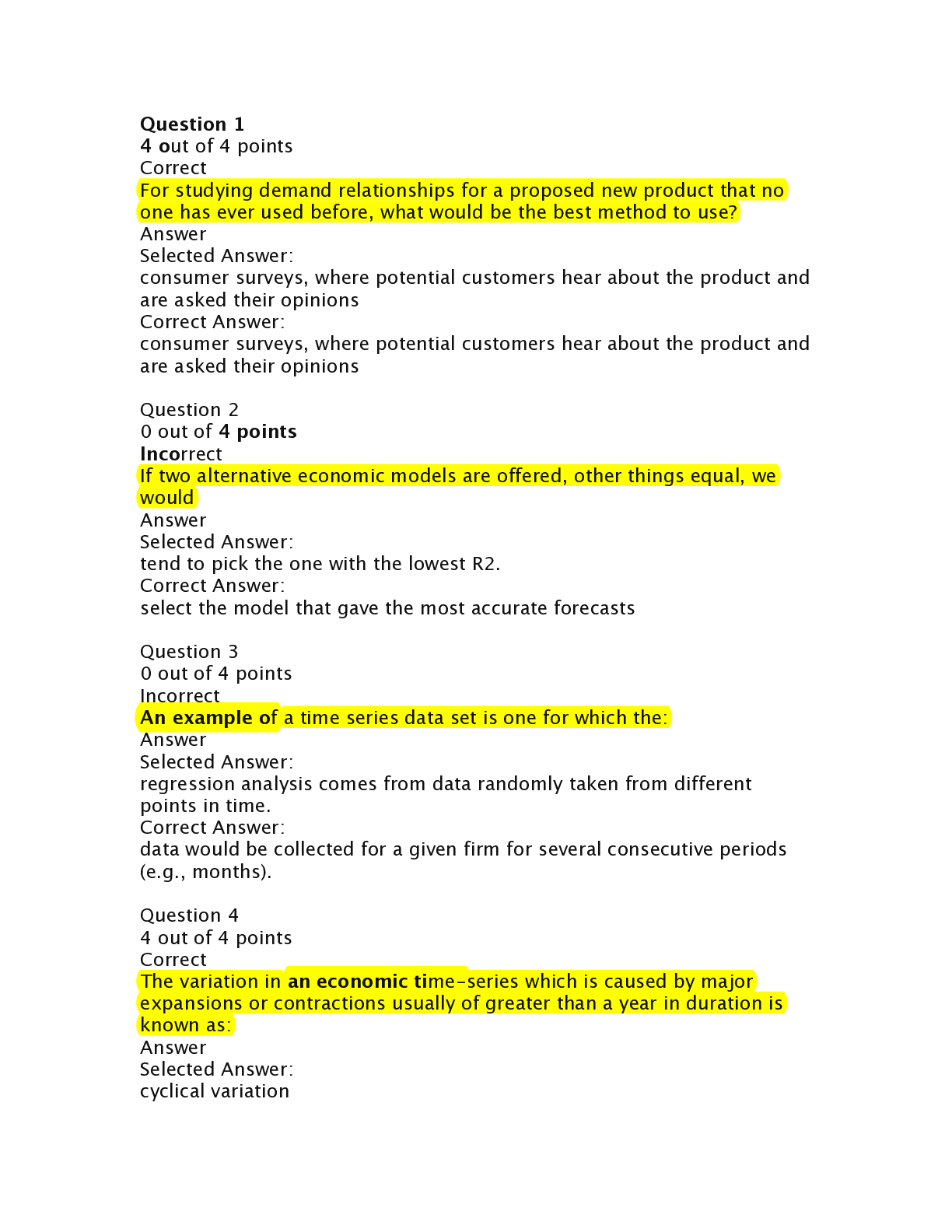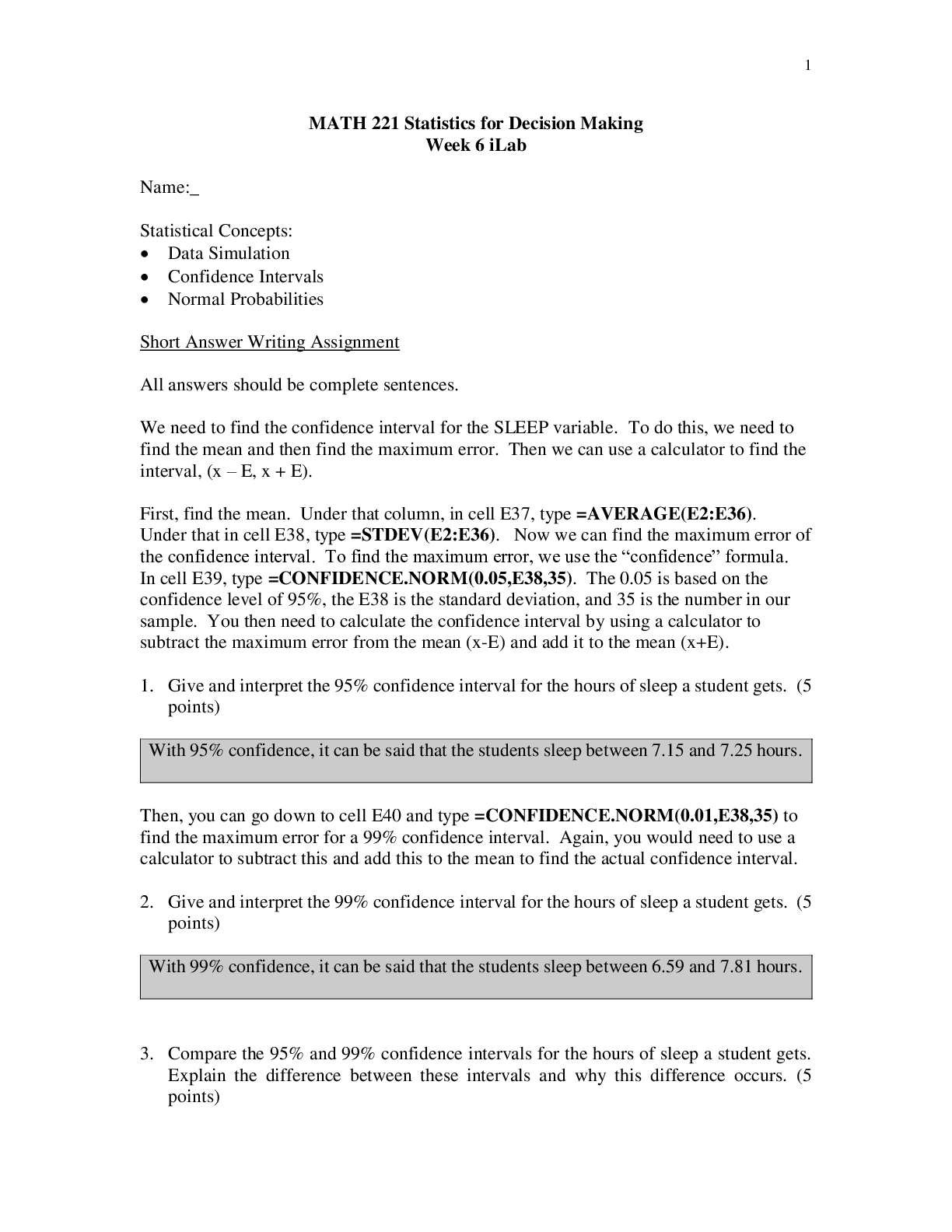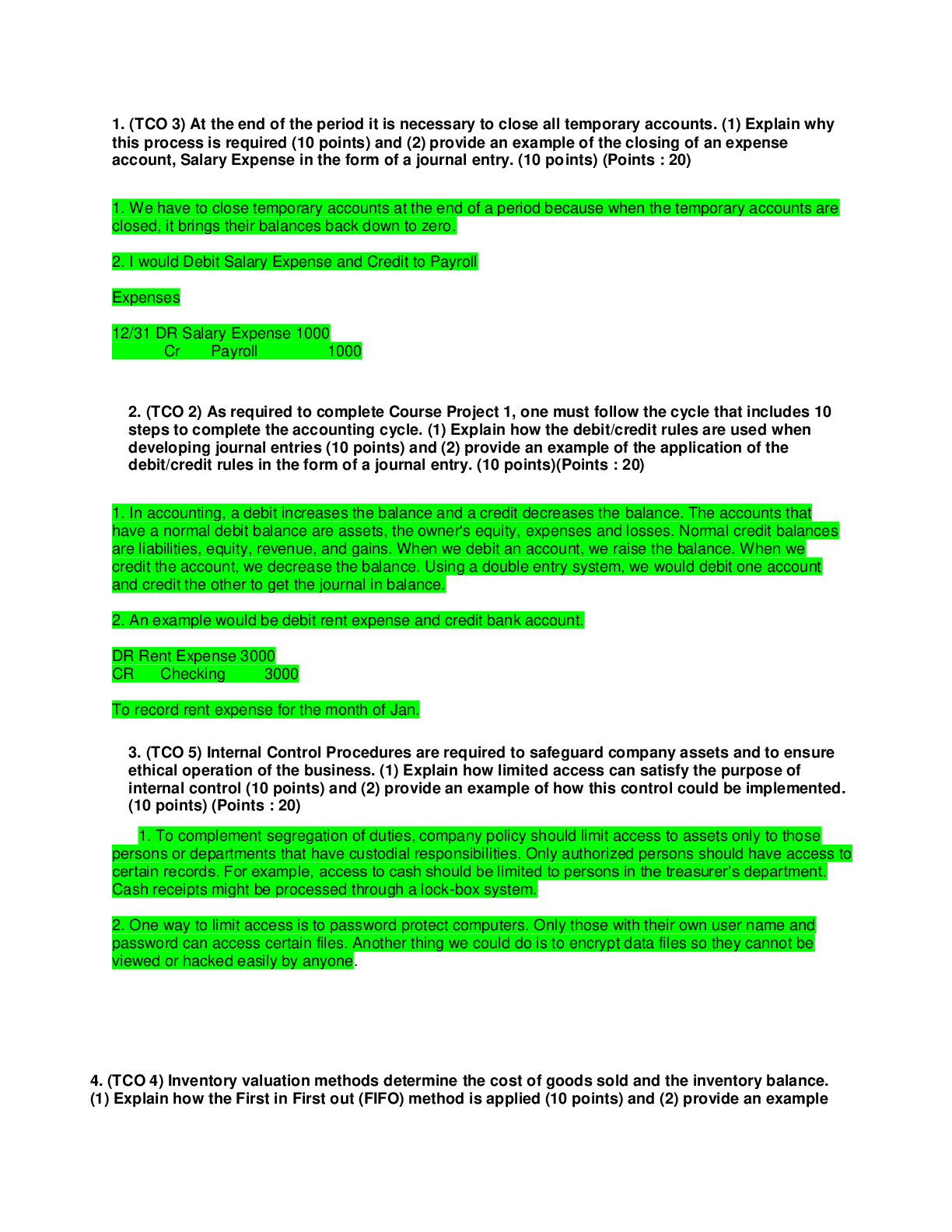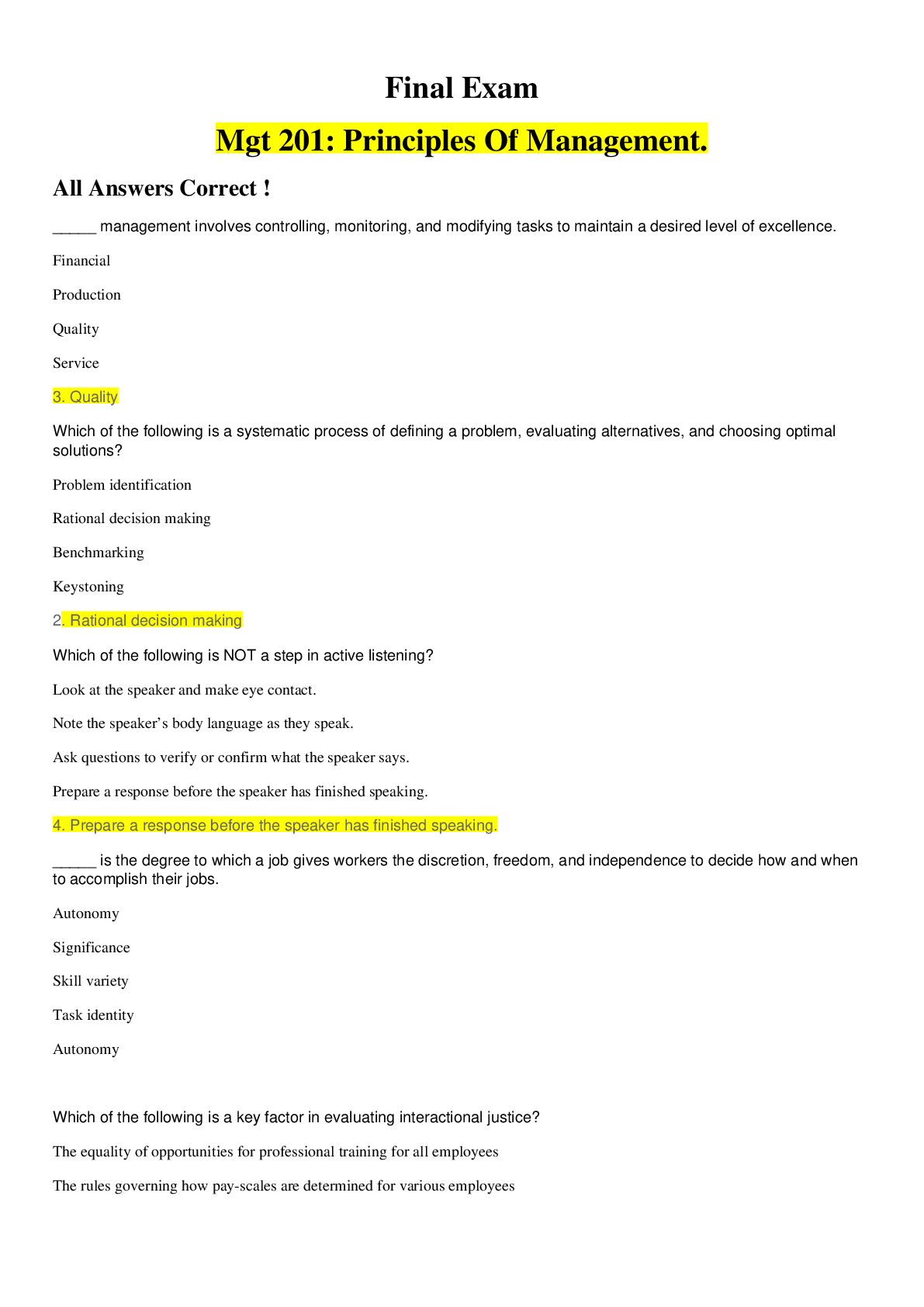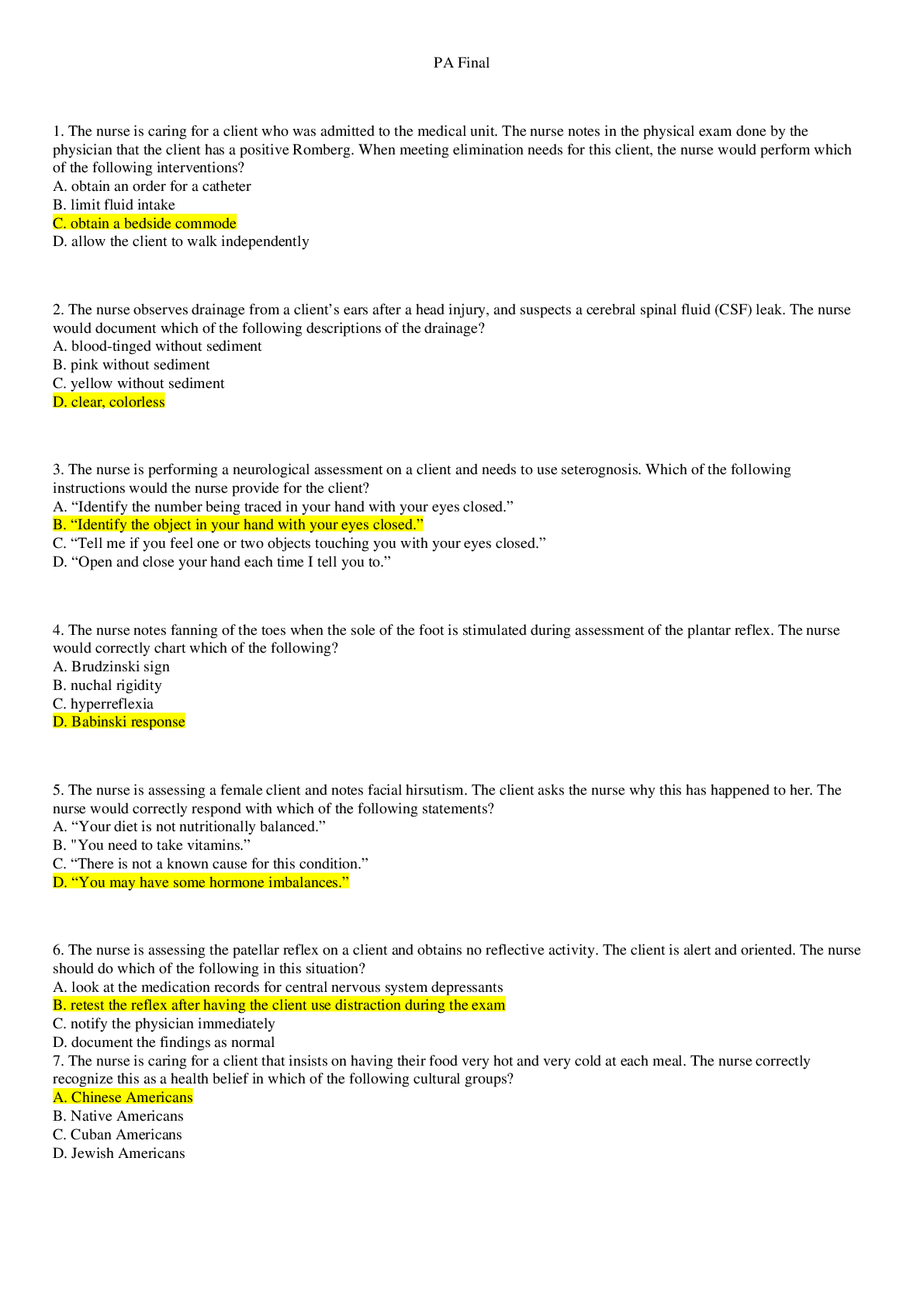*NURSING > EXAM > NURS 6531 Final Exam | (101 QUESTIONS & ANSWER) | 100 % CORRECT | ALREADY GRADED A+ (All)
NURS 6531 Final Exam | (101 QUESTIONS & ANSWER) | 100 % CORRECT | ALREADY GRADED A+
Document Content and Description Below
NURS 6531 Final Exam Question 2. Which of the following is a potential acquired cause of thrombophilia? Question 3 Phalen’s test, 90°wrist flexion for 60 seconds, reproduces symptoms of: ... Ulnar tunnel syndrome Carpal tunnel syndrome Tarsal tunnel syndrome Myofascial pain syndrome Question 4 Which patient would benefit most from screening for type 2 diabetes? A 30 year old female with unintended weight loss. A 25 year old male with family history of type 1 diabetes An obese female with recurrent vaginitis A 50 year old hyperlipidemic male Question 5 Rheumatoid arthritis (RA) Osteoarthritis (OA) Lupus Peripheral neuropathy Question 6 Trimethoprim-sulfamethoxazole for 3 days Ciprofloxacin for 7-10 days Trimethoprim-sulfamethoxazole for 14 days Ciprofloxacin for 3 days A thymectomy is usually recommended in the early treatment of which disease? Question 8 The diagnosis of human papilloma virus (HPV) infection in males is usually made by: Clinical appearance Viral culture Tzanck smear KOH prep Question 9 The most effective intervention(s) to prevent stroke is (are): 81 mg of aspirin daily Carotid endarterectomy for patients with high-grade carotid lesions Routine screening for carotid artery stenosis with auscultation for bruits Smoking cessation and treatment of hypertension Question 10 What is the most common cause of Cushing’s syndrome? Excessive ACTH production Administration of a glucocorticoid or ACTH Pituitary adenoma or a non-pituitary ACTH- producing tumor Autonomous cortisol production from adrenal tissue Question 11 Routinely after 3 weeks of low back pain symptoms. To screen for spondylolithiasis in patients less than 20 years of age with 2 weeks of more of low back pain. When there is a suspicion of a space-occupying lesion, fracture, cauda equina, or infection. As a part of a pre-employment physical when heavy lifting is included in the job description. Question 12 An enzyme-linked immunosorbent assay titer A urea breath test A rapid urease test A repeat endoscopy Question 13 MMSE CAGE questionnaire FAQ – Functional Activities Questionnaire Holmes and Rahe social readjustment scale Question 14 A. Myocardial infarction Parkinson’s disease Stroke Alzheimer’s disease Question 15 Which of the following statements about multiple sclerosis (MS) is correct? MS is a chronic, untreatable illness that is almost always fatal. MS is a disease of steadily progressive and unrelenting neurologic deterioration. MS is a chronic, treatable illness with unknown cause and a variable course. Patients with MS who take active steps to improve their health have the best cure rate. Question 16 Diagnostic evaluation of hypothyroidism reveals: Elevated TSH and decreased T4 Decreased TSH and increased T4 Decreased TSH and decreased T3 Elevated TSH and increased T4 Question 17 Risk factors for prostate cancer include all of the following except: Family history Benign prostatic hypertrophy African American race Age Question 18 Hypoglycemia is a rare complication. Hypoglycemia requires professional medical treatment. Hypoglycemia is serious, dangerous, and can be fatal if not treated quickly. Hypoglycemia occurs only as a result of insulin overdose. Question 19 Which history is commonly found in a patient with glomerulonephritis? Beta-hemolytic strep infection Frequent urinary tract infections Kidney stones Hypotension Question 20 Which of the following is characteristic of a manic episode? weight loss of gain insomnia or hypersomnia diminished ability to think or concentrate grandiose delusions Question 21 Central obesity, “moon” face, and dorsocervical fat pad are associated with: Metabolic syndrome Unilateral pheochromocytoma Cushing’s syndrome None of the above Question 22 Which of the following is the most common cause of low back pain? Lumbar disc disease Spinal stenosis Traumatic fracture Osteoporosis Question 23 Infection Toxoplasmosis Mononucleosi s All of the above None of the above Question 24 Weight gain Fracture risk Hypoglyce mia Weight loss Question 25 cryptococcosi s toxoplasmosi s cryptosporidi osis cytomegalovi ru Question 26 Which of the following is the most common causative organism of nongonococcal urethritis? Chlamydia trachomatis Ureaplasma urealyticum Mycoplasma hominis Trichonomas vaginalis Question 27 The most common symptoms of transient ischemic attack (TIA) include: Nausea, vomiting, syncope, incontinence, dizziness, and seizure. Weakness in an extremity, abruptly slurred speech, or partial loss of vision, and sudden gait changes. Headache and visual symptoms such as bright spots or sparkles crossing the visual field. Gradual onset of ataxia, vertigo, generalized weakness, or lightheadedness Question 28 What is the first symptom seen in the majority of patients with Parkinson’s disease? Rigidity Bradykinesi a Rest tremor Flexed posture Question 29 1–4 red blood cells per high- powered field Specific gravity 1.012 Urobilinogen 10- white blood cells per high- powered field Question 30 Radial tunnel syndrome Ulnar collateral ligament sprain Olecranon bursitis Lateral epicondylitis Question 31 Depression Panic disorder Anxiety Post-traumatic stress disorder Question 32 Trauma Tight shoes Arthritis flare Hydrochlorothia zide Question 33 Which of the following is a contraindication for metformin therapy? Insulin therapy Creatinine > 1.5 Edema None of the above Question 34 A positive drawer sign supports a diagnosis of: Sciatica Cruciate ligament injury Meniscal injury Patellar ligament injury Question 35 Apples Pepperm int Cucumb ers Popsicles Question 36 A patient taking levothyroxine is being over-replaced. What condition is he at risk for? Osteoporo sis Constipati on Depressio n Exopthal mia Question 37 HbA1C 2-hour 75 gram oral glucose tolerance test C-peptide level A and B All of the above Question 38 Prescribe systemic antibiotics Prescribe antibiotic ear drops Prescribe nasal steroids and oral decongestants Refer him to an ear, nose, and throat specialist Question 39 Maintain moderate bed rest for 3-4 days Call the office for narcotics if there is no relief with the NSAID in 24-48 hours Begin lower back strengthening exercises depending on pain tolerance Wear a Boston brace at night Question 40 Risk factors for Addison’s disease include which of the following? Tuberculosis Autoimmune disease AIDS All of the above Question 41 Urine cultures should be obtained for which of the following patients? Suspected urinary tract infection in pregnancy Febrile patients Young men All of the above Question 42 “Caffeine has not effect on osteoporosis.” “A high caffeine intake has a diuretic effect that may cause calcium to be excreted more rapidly.” “Caffeine affects bone metabolism by altering intestinal absorption of calcium and assimilation of calcium into the bone matrix.” “Caffeine increase bone resorption.” Question 43 Migraine headache Subarachnoid hemorrhage Glaucoma Meningitis Question 44 You must initiate the plan of care for the patient The physician must be on-site and engaged in patient care You must be employed as an independent contractor You must be the main health care provider who sees the patient Question 45 Digital rectal examination (DRE) plus prostate specific antigen (PSA) Prostate specific antigen (PSA) alone Transrectal ultrasound (TRUS) alone Prostate specific antigen (PSA) and transrectal ultrasound (TRUS) Question 46 The primary goals of treatment for patients with alcohol abuse disorder are: Reduction in withdrawal symptoms and reduction in desire for alcohol Psychotherapeutic and pharmacological interventions to decrease desire for and effects of alcohol Abstinence or reduction in use, relapse prevention, and rehabilitation Marital satisfaction, improvement in family functioning, and reduction in psychiatric impairment Question 47 Lateral meniscus Cruciate ligament Medical meniscus Collateral ligament Question 48 Musculoskeletal pain Difficulty sleeping Depression Fatigue Question 49 Differential diagnosis of proteinuria includes which of the following? Orthostatic proteinuria Nephrotic syndrome Infection Trauma A and B Question 50 Underweigh t Normal weight Overweight Obese Question 51 Reed-Sternberg B lymphocytes are associated with which of the following disorders: Aplastic anemia Hodgkin’s lymphoma Non Hodgkin’s lymphoma Myelodysplastic syndromes Question 53 Arthritis Ulnar neuritis Septic arthritis Olecranon bursitis Question 54 Establishment of a definitive diagnosis of osteomyelitis requires: A known causative injury such as a puncture wound, bite, or decubitus ulcer. Biopsy of culture of the pathogen from blood or bone aspirate. Visualization of purulent material draining into soft tissue. Lucent areas identified on plain x-ray. Question 55 The most accurate measure of diabetes control is: Avoidance of micro- and macro-vascular complications. Insulin sensitivity. Early morning glucose levels. HgbA1c Question 56 Alprazolam or diazepam Venlafaxine or buspirone Trazodone or sertraline Venlafaxine or hydroxyzine pamoate Question 57 The most common presentation of thyroid cancer is: Generalized enlargement of the thyroid gland. A solitary thyroid nodule. A multinodular goiter. Abnormal thyroid function tests. Question 58 Cigarette smoke, both active and passive inhalation Chemicals from plastic and rubber Chronic use of phenacetin-containing analgesic agents Working long hours and not voiding often Question 59 Sjogren’s syndrome Pancreatic cancer Disseminated malignancy of the hematologic system Cancer of the liver Question 60 Refer her to a hand surgeon Take a more complete history Try neutral position wrist splinting and oral NSAID Order a nerve conduction study such as am electromyography Question 61 Corticosteroids Inhaled beta-2 agonist bronchodilators Inhaled anticholinergic bronchodilators Xanthines Question 62 Potential causes of septic arthritis include which of the following? Lyme disease Prosthetic joint infection Reiter’s syndrome A and B All of the above Question 63 Oral ciprofloxacin (Cipro) Oral doxycycline (Virbamycin) plus intramuscular ceftriaxone Oral trimethoprim-sulfamethoxazole (Bactrim DS) Intramuscular penicillin Question 64 Advise the patient to stop the antidepressant medication Question the patient to determine if the self-assessment is correct before advising her to discontinue the medication Recommend that the patient continue the antidepressant medication for at least 4 more months Discuss with the patient the need to take the antidepressant medication indefinitely Question 65 Iron-deficiency anemia Hemolytic anemia Lead poisoning Liver disease Question 66 Which of the following medications increase the risk for metabolic syndrome? Antihistamines Proton pump inhibitors Protease inhibitors A and C All of the above Question 67 Acoustic neuroma Astrocytoma of the retina Distinctive osseous lesions Café au lait spots Question 68 Acetaminophen or an NSAID A muscle relaxant as an adjunct to an NSAID An oral corticosteroid and diazepam (Valium) Colchicine and an opioid analgesic Question 69 Legal authority for advanced practice nursing rests with: The Health Care Financing Administration Federal statutes State laws and regulations Certifying bodies Question 70 Superficial and deep heat Application of cold Transcutaneous electrical nerve stimulation (TENS) Exercise Question 71 A patient presents with dehydration, hypotension, and fever. Laboratory testing reveals ponatremia, hyperkalemia, and hypoglycemia. These imbalances are corrected, but the patient returns 6 weeks later with the same symptoms of hyperpigmentation, kness, anorexia, fatigue, and weight loss. What action(s) should the nurse practitioner take? Obtain a thorough history and physical, and check serum cortisol and ACTH levels. Obtain a diet history and check CBC and FBS. Provide nutritional guidance and have the patient return in 1 month. Consult home health for intravenous administration of fluids and electrolytes. Question 72 Start him on an ACE Inhibitor Start him on a diuretic Have him monitor his blood pressure at home Try nonpharmacological methods and have him monitor his blood pressure at home Martin is complaining of erectile dysfunction. He also has a condition that has reduced arterial blood flow to his penis. The most common cause of this condition is: Question 74 Hypertriglyceridemia and low high-density lipoprotein (HDL) Gestational diabetes and polycystic ovarian syndrome Hispanic, African-American, Native-American, and Pacific Islander ethnicity Postprandial hypoglycemia Question 75 The patient should start anticoagulant therapy immediately. Hereditary thrombophilia does not always require anticoagulation therapy. Women of childbearing age cannot take anticoagulant therapy. Genetic and risk management counseling are recommended. B and D Question 76 The 4 classic features of Parkinson’s disease are: Mask-like facies, dysarthria, excessive salivation, and dementia. Tremor at rest, rigidity, bradykinesia, and postural disturbances. Depression, cognitive impairment, constipation and shuffling gait. Tremor with movement, cogwheeling, repetitive movement, and multi-system atrophy. Question 77 Which of the following set of symptoms should raise suspicion of a brain tumor? Recurrent, severe headaches that awaken the patient and are accompanied by visual disturbances. Vague, dull headaches that are accompanied by a reported sense of impending doom. Periorbital headaches occurring primarily in the evening and accompanied by pupillary dilation and photophobia. Holocranial headaches present in the morning and accompanied by projective vomiting without nausea. Question 78 The most common cause of elevated liver function tests is: Hepatitis Biliary tract obstruction Chronic alcohol abuse A drug-induced injury Question 79 The physiological explanation of syncope is: Accelerated venous return and increased stroke volume resulting in deactivation of the parasympathetic nervous system. A cycle of inappropriate vasodilation, bradycardia, and hypotension. A sudden rise in blood pressure due to overly efficient vasoconstriction. Emotional stress resulting in hypertension, tachycardia, and increased venous return. Question 80 Thiazide diuretic Insulin Famotidine (Pepcid) Albuterol Question 81 Affected joint is painful at rest, with movement and weight bearing Rapid onset that wakes the patient during the night Long history of severe pain with associated joint swelling None of the above Question 82 Primary hyperparathyroidism is treated with Vitamin D restriction Primary hyperparathyroidism is treated with parathyroidectomy Primary hyperparathyroidism is treated with daily magnesium Primary hyperparathyroidism is treated with parenteral parathyroid hormone (PTH) Question 83 Doxycycline 100 mg qd Nitrofurantoin 100 mg qd Bactrim DS qd Erythromycin qd Question 84 Who is at a higher risk for developing nephrolithiasis? Jack, who exercises every day and drinks copious amounts of water Mary, who watches her weight and eats a low-sodium diet Harvey, a “couch potato” who drinks a lot of no- sodium soda Bill, who runs every day and takes excessive amounts of vitamin C Question 85 Potential side effects of levofloxacin include which of the following? Confusion Hypoglycemia Achilles tendon rupture All of the above Although most of your symptoms will disappear, some will remain but can usually be camouflaged by altering your hairstyle or growing a beard Unfortunately there is no cure but you have a mild case The condition is self-limiting and most likely complete recovery will occur With suppressive drug therapy you can minimize the symptoms Change to a different class of antihypertensive medication to get better control. Increase the dosage of the current BP medication. Continue the current medication and dosage for 4 more weeks. Add a beta-blocker to the current medication regimen. Question 88 1, 2, 3 2, 3, 4 1, 3, 4 1, 2, 4 Question 89 Diagnostic confirmation of acute leukemia is based on: Bone marrow aspiration and biopsy Pancytopenia Hyperuricemia All of the above Question 90 A dipstick strip done during routine urinalysis in the office A 24-hour urine collection An early morning spot urine collection A serum albumin test Question 91 Trimethoprim- sulfamethoxazole Erythromycin Cefuroxime Levofloxacin Question 92 Wash your feet with cold water daily See a podiatrist every 2 years, inspect your own feet monthly, and apply lotion to your feet daily Go to a spa and have a pedicure monthly See a podiatrist yearly; wash your feet daily with warm soapy water and towel dry between the toes; inspect your feet daily for lesions; apply lotion to dry areas Question 93 Psychotherapy Electroconvulsive therapy (ECT) A selective serotonin reuptake inhibitor (SSRI) A tricyclic antidepressant (TCA) Question 94 The initial clinical sign of Dupuytren’s contracture is: Pain with ulnar deviation Painless nodule on palmer fascia Pain and numbness in the ring finger Inability to passively extend finger Question 95 Fatigue Cardiomyopa thy Falls Bleeding Question 96 Buy good walking shoes with support and a flexible sole. Exercise at least 5 days per week. Snack before exercise. Do not exercise if your blood sugar is greater than 180 mg/dL Question 97 What is the most commonly abused substance? Heroin Cocaine Alcohol Marijua na Question 98 “You’re right; it seems like your diabetes is improving.” “Because your kidneys are not functioning well, your insulin is not being metabolized and excreted as it should, so you need less of it.” “You have watched your diet for all these years and as a result, your body is using less insulin.” “I will have to change your oral hyperglycemic agents as it seems your body is making more insulin.” Question 99 Decrease the evening insulin dose and check capillary blood glucose (CBG) at 2:00 am. Instruct the child’s parents on physical activities to help weight loss. Increase the evening insulin dose and check CBG at 2:00 am. Refer the child for instruction on a strict diabetic diet. Question 100 At what age is screening most likely to detect scoliosis? 4 to 6 years 8 to 10 years 12 to 14 years 18 to 20 years Question 101 Patient report of bladder dysfunction, saddle anesthesia, and motor weakness of limbs. History of significant trauma relative to the patient’s age. Decreased reflexes, strength, and sensation in the lower extremities. Patient report of pain with the crossed straight leg raise. [Show More]
Last updated: 1 year ago
Preview 1 out of 35 pages
Instant download
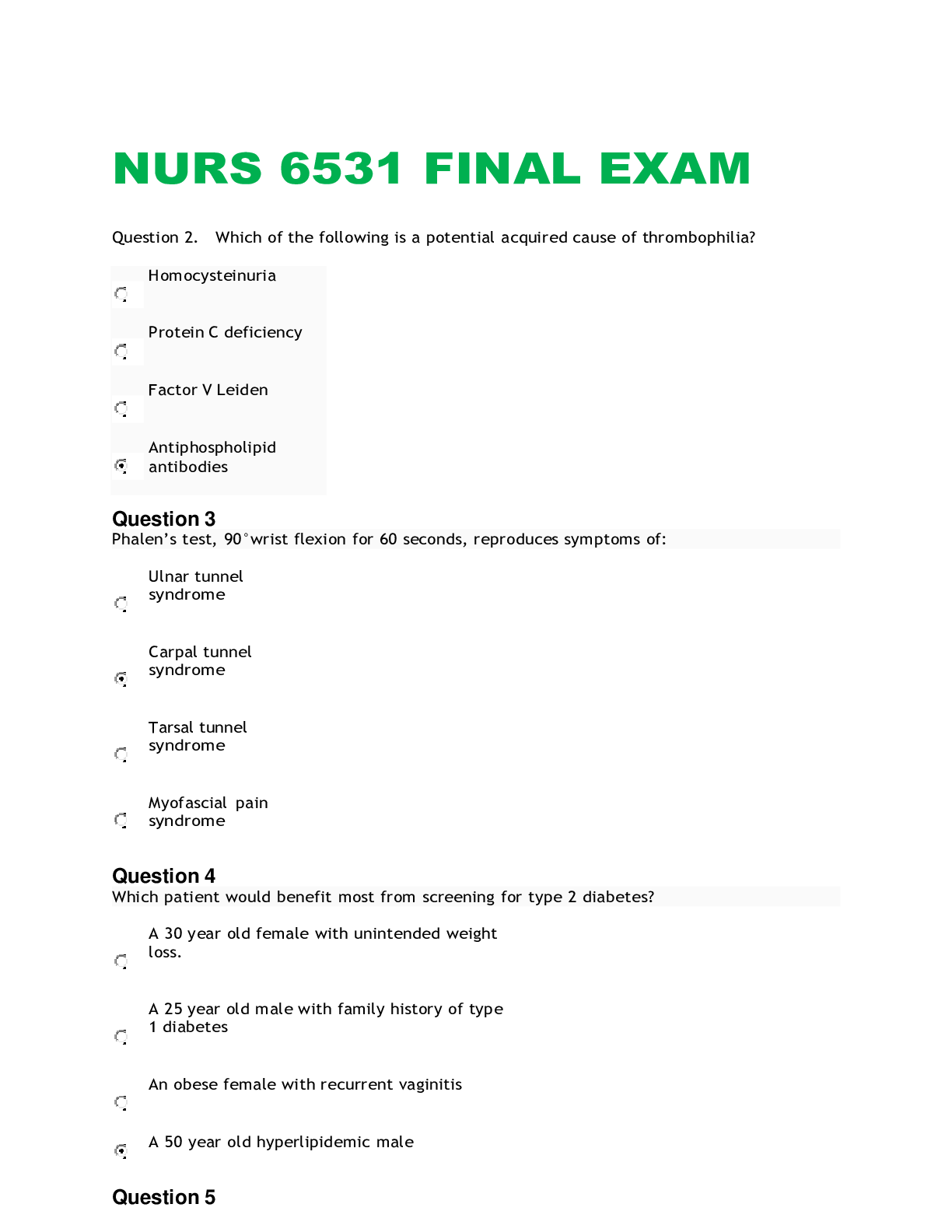
Buy this document to get the full access instantly
Instant Download Access after purchase
Add to cartInstant download
Reviews( 0 )
Document information
Connected school, study & course
About the document
Uploaded On
May 12, 2021
Number of pages
35
Written in
Additional information
This document has been written for:
Uploaded
May 12, 2021
Downloads
0
Views
34






.png)






